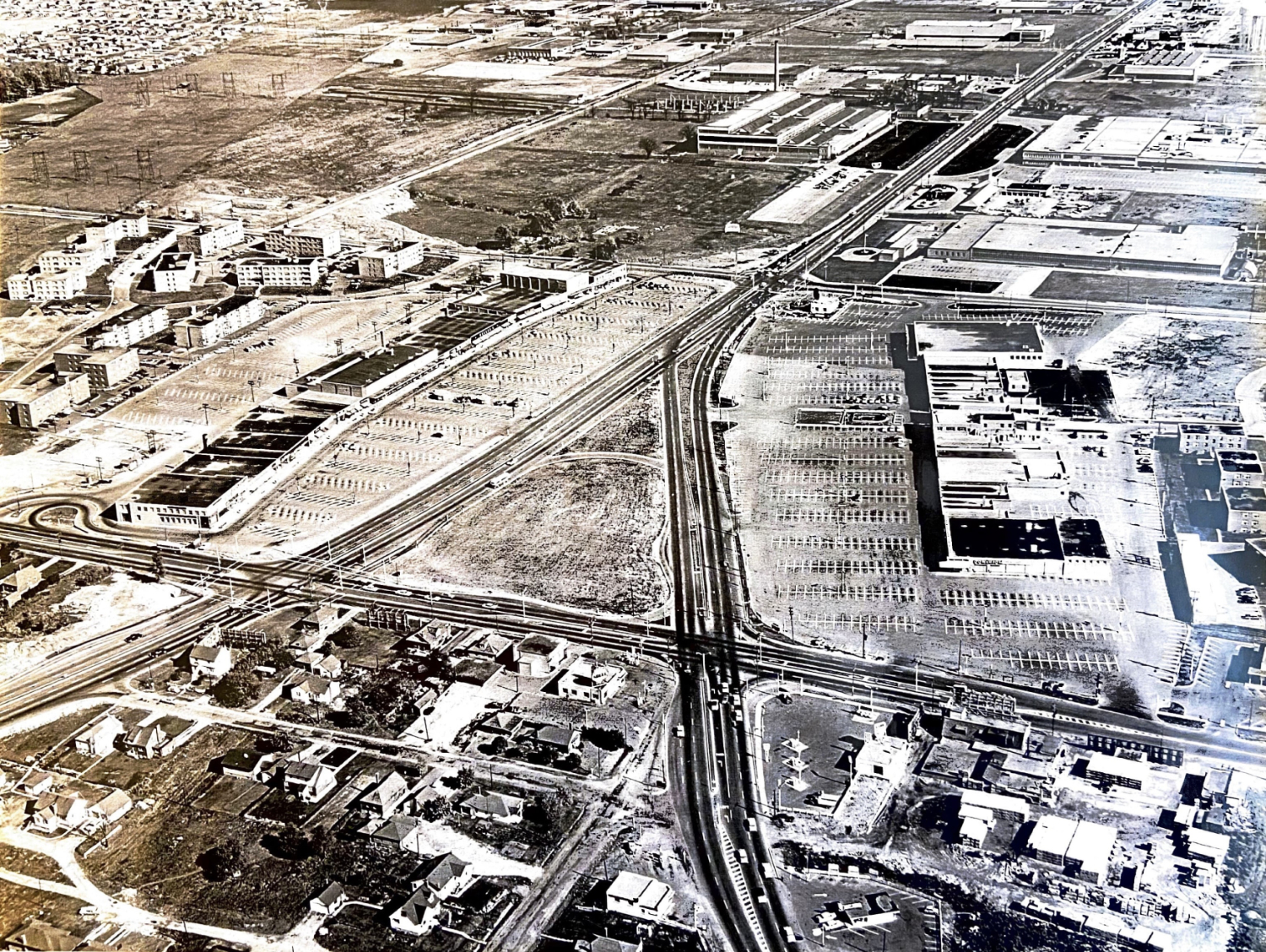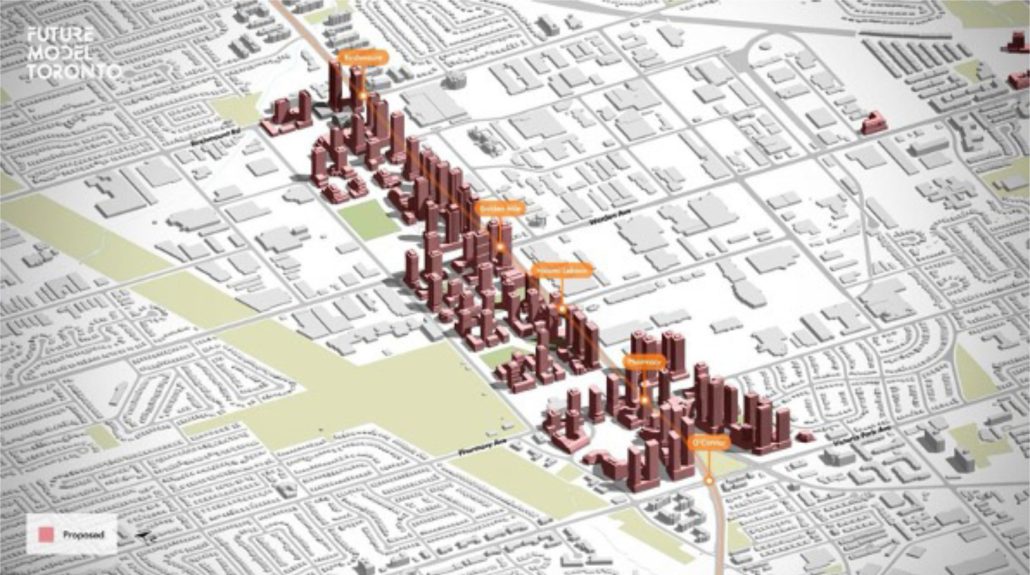


Golden Mile in 1949. Photo courtesy of Rick Schofield, Scarborough Archives
This neighbourhood’s vibrant legacy has laid the foundation for a strong, vibrant future
The Golden Mile and surrounding neighbourhoods (known as the Greater Golden Mile) is lined with stores, services and bus stops that residents rely on every day, and the new Eglinton Crosstown LRT will soon be active. The commercial corridor of the neighbourhood, which stretches along Eglinton Avenue East between Victoria Park Avenue and Birchmount Road, will be home to up to 45,000 new residents as around 75 buildings go up in the next 20 years.
To understand the Greater Golden Mile’s evolution, it’s helpful to know how it all started.
This neighbourhood got its start
That story goes back to the late 1940s, when Oliver Crockford, who was then reeve of the Township of Scarborough, convinced the town council to buy a parcel of land along Eglinton Avenue East. The land — once used by factories to fill heavy ammunition items for the military – sprawled across 250 acres and had an estimated value of $7 million at the time.
Crockford, who was the equivalent of a mayor, negotiated a deal with the federal government to buy the land for just $350,000, which would be roughly $6.9 million today.
The Golden Mile’s industrial era
In the 1940s, the Golden Mile began a radical transformation to a vibrant urban centre. Soon it was home to industrial operations, booming employment and mass housing construction for the area’s growing population.
During the Second World War, the federally-owned General Engineering Company (GECo) played a pivotal role in the area. It produced ammunition.
After the war, many prominent companies were attracted to the Golden Mile by its reputation, including Frigidaire.
“Prior to the 1950s, many people had a refrigerator, but it didn’t plug into the wall,” said Rick Schofield, an archivist at the Scarborough Archives.
“You would order a block of ice, and it would go into the top of your big icebox; a natural refrigerator that kept everything cold. When the ice melted … you’d order another block.”
Frigidaire, an American company, set up manufacturing and assembly facilities in the Golden Mile, in the 1950s. The company introduced electric refrigerators that you could plug into the wall.
“This change in the industry was mainly because of the growing population in Scarborough,” Schofield said.
“People were moving into new houses, and they wanted modern appliances.”
The Golden Mile also became a hub for manufacturing and warehousing businesses, specializing in metalworking, electrical equipment and the automotive business. All of the growth – and the related job opportunities – attracted residents. People could seamlessly combine work and leisure, taking advantage of the diverse amenities offered in the area.
The rise of retail
The 1950s brought exciting shopping opportunities to the Golden Mile, with the opening of Eglinton Square Shopping Centre and the Golden Mile Plaza near Victoria Park Avenue and Eglinton Avenue East. Newer structures that replaced the open-air strip plazas still exist in the same area. It was a new concept – an enclosed shopping mall. People could now stroll with trolleys (referred to as buggies) in a modern, climate-controlled environment. It quickly became a hotspot for fashion retailers.

Across Eglinton Avenue, the curtains rose at the Golden Mile Theatre at the Golden Mile Plaza on Oct. 14, 1954. It is believed to be the first movie theatre inside a shopping mall in Canada. Moviegoers gathered for its first screening of Up In Arms, starring Danny Kaye, and Our Very Own, featuring Ann Blythe and Farley Granger. The theatre was nestled near the plaza’s east side, at the intersection of Eglinton Avenue East and Pharmacy Avenue. Originally a single grand theatre, it was transformed in 1978 into two separate cinemas and was a cherished part of the scene until the plaza’s redevelopment in the early 1990s.
The area became such a draw that Queen Elizabeth II made a brief stop during her visit to Toronto in June 1959 – and reportedly popped into the Loblaws at the Golden Mile Plaza
The Golden Mile’s more recent chapters
As the years went by, many of the large industries that once defined the Golden Mile moved away, and newer shopping malls in other parts of the Greater Toronto Area held more appeal for some shoppers.
Now, there are plans afoot to redevelop the Greater Golden Mile to pave a path for future generations. The Inclusive Local Economic Opportunity initiative (ILEO), convened by United Way Greater Toronto and BMO Financial Group, is offering programming that will ensure residents benefit from the changes as the Golden Mile evolves once more.
This story was produced as part of a partnership between Centennial College journalism students and United Way Greater Toronto.

The Centre for Inclusive Economic Opportunity, Golden Mile (CIEO) is a not-for-profit organization founded in 2020 by 10 community organizations to expand economic opportunities for residents of the Greater Golden Mile.
The ILEO Initiative brings together the private, public, and community sectors to find innovative ways to reduce gaps in economic prosperity at the neighbourhood level. ILEO is convened by United Way Greater Toronto and BMO Financial Group.